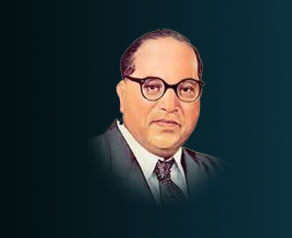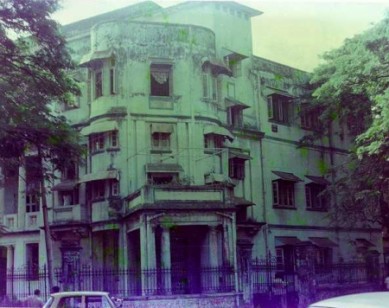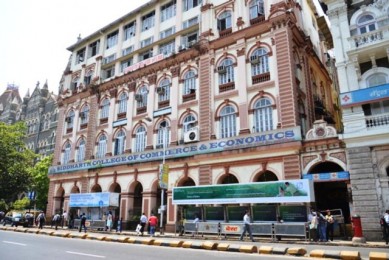 Dr. Babasaheb Ambedkar
Dr. Babasaheb Ambedkar House of Dr. Ambedkar
House of Dr. Ambedkar
Today is the day when the nation celebrates the 125th Birth Anneversary of B. R. Ambedkar who is popularly known as Bhimrao Ambedkar. I had the unique opportunity of living in his house called as “Rajgruh†in Hindu Colony, Dadar, Mumbai. It was my good luck which took me to Mumbai for my law studies. Ther were no law colleges in Mangalore in those days. People used to go to Belgaum or Madras, now called as Belgauvi and Chennai. I wanted to prosecute my studies as it used to be popularly called in those days as “earn while you learn†method. I thought I could get employment in Mumbai easily and then prosecute my studies. But attempts to get a job was not easy. It was not so easy to get jobs even in those days. Even the journey to Mumbai was very circuitous. One had to go by bus upto a railway head called Kadur and then travel by train to Mumbai. It used to be two days journey. My friends said that the best law college which could give such opportunities to learn and earn was a college situated in Flora Fountain called Siddharth College of law. It was started by Baba Saheb Ambedkar under the auspices of People’s Education Society. Instead of writing my own on that college, I would repeat what its college prospectus said.
“People’s Education Society, which was founded on 8th July, 1945 by Bharat Ratna Dr.Babasaheb Ambedkar,M.A., Ph.D., D.Sc. (London)., LL.D. (Columbia ), D.Lit. (Osmania), Bat-at-law. The Society runs the various academic institutions throughout India including Siddharth College of Law which was established in the year 1956 at Prime locality of city of Mumbai in a heritage building called ” Anand Bhavan”.. People’s Education Society derives its inspiration from the teaching and ideals of Lord Buddha. lt believes in the principles of social justice. lt functions for establishing social justice. It’s primary aim is to promote higher education among the poorer people in general and Buddhists,Scheduled Castes and Scheduled Tribes and other Backward Classes in particular. lts motto is “Knowledge and love’for `knowledge is power and Love governs the whole universe. According to Dr.Babasaheb Ambedkar the object of the people’s Education Society is not merely to give education but to give social democracy.This is what modern tndia needs and this is what all well-wishers of India must promote.The society is inspired by five great ideals of the founder, The ideal of knowledge, the ideals of compassion,the ideal of democracy,the ideal of equality and the ideal of justice”
The college was situated at a Very convenient location from where one could go for work and reach from any corner of Mumbai. Another attraction was that the classes were a part time – morning and evening college and there was possibility of getting Hostel accommodation. I applied and the only question that was asked was whether I wanted to earn and learn and my answer was one emphatic yes. I got the accommodation. One Sri P.T.Borale was the Principal who encouraged the students not to be a burden on their parents. I got hostel accommodation. It was at that time I got the unique opportunity of living in Rajgruh. In those days .the house of BabaSaheb had been converted as the hostel of the college. I was so happy that I could not only boast of that privilege but also felt blessed that I could stay and breath and go round in the same house where the architect of Indian Constitution lived.
It is a big bungalow type house with a portico. In front of it there was a park on the other side of the road. Rooms were spacious and two or three students used to stay in each room. My room could be seen from the road. It was the first room on the left side of the Ist Floor, if one stands in the road. This stay and studies in the institutions promoted by Baba Saheb Ambedkar has now prompted me to pay my tributes to that great iconic leader who strived for the emancipation of the less privileged people. He was born to Bhimabai Sakpal and Ramji on 14th April, 1891 in Madhya Pradesh. He was the fourteenth child of his parents. His parents hailed from the Hindu Mahar caste, which was viewed as “untouchable” by the upper class. Due to this, Ambedkar had to face severe discriminations from every corners of the society. Wherever he went for his education, he was a victim of caste discrimination. Discrimination followed wherever he went. He was one of the architects of the Indian Constitution. Ambedkar began to find ways to reach to the people and make them understand the drawbacks of the prevailing social evils. He launched a newspaper called “Mooknayaka” ( leader of the silent He was a well-known politician and an eminent jurist. Ambedkar’s efforts to eradicate the social evils like untouchablity and caste restrictions were remarkable. The leader, throughout his life, fought for the rights of the dalits and other socially backward classes. Ambedkar was appointed as the nation’s first Law Minister in the Cabinet of Jawaharlal Nehru.
In 1950, Ambedkar traveled to Sri Lanka to attend a convention of Buddhist scholars and monks. After his return he decided to write a book on Buddhism and soon, converted himself to Buddhism. In his speeches, Ambedkar lambasted the Hindu rituals and caste division. Ambedkar founded the Bharatiya Bauddha Mahasabha In 1955. His book “The Buddha and His Dhamma” was published posthumously.
He was posthumously awarded the highest civilian honour of Bharath Rathna in 1990
Here are some of his quotes which show his thinking and the cause for which dedicated his entire life. “Caste system is a social division of people of the same race†he said. “ The name Hindu is itself a foreign name. It was given by the Mohammadens to the natives for the purpose of distinguishing themselves. It does not occur in any Sanskrit work prior to the Mohammedan invasion. They did not feel the necessity of a common name because they had no conception of their having constituted a community.†He said that “Hindu Society as such does not exist. It is only a collection of castes Each caste is conscious of its existence. Its survival is the be all and end all of its existenceâ€
He held the view that the ideal Hindu must be a rat living in his own hole refusing to have any contact with others.†There cannot be a more degrading system of social organization than the Chaturvarnya. It is the system which deadens, paralyses and cripples the people from helpful activity
He held the view that there is only one period in Indian history which is a period of freedom, greatness and glory. That is the period of the Mourya Empire. At all other times the country suffered from defeat and darkness. But the Mourya period was a period when Chaturvarnya was completely annihilated, when the Shudras, who constituted the mass of the people, came into their own and became the rulers of the country.
The priestly class must be brought under control by some such legislation as I have outlined above. It will prevent it from doing mischief and from misguiding people. It will democratise it by throwing it open to every one. It will certainly help to kill the Brahminism and will also help to kill Caste, which is nothing but Brahminism incarnate Ambedkar objected to the decision of Congress and Mahatma Gandhi to call the untouchable community as Harijans. He would say that even the members of untouchable community are same as the other members of the society. Hindus realize that they are the sick men of India and that their sickness is causing danger to the health and happiness of other Indians Caste system is a social division of people of the same race lower caste people. In Hinduism, conscience, reason and independent thinking have no scope for development. Life should be great rather than long He also favored the concept of providing reservations for Dalits and other religious communities.
In 1936, Ambedkar founded the Independent Labor Party. In the 1937 elections to the Central Legislative Assembly his party won 15 seats. Ambedkar oversaw the transformation of his political party into the All India Scheduled Castes Federation, although it performed poorly in the elections held in 1946 for the Constituent Assembly of India.
Ambedkar objected to the decision of Congress and Mahatma Gandhi to call the untouchable community as Harijans. He would say that even the members of untouchable community are same as the other members of the society. Ambedkar was appointed on the Defence Advisory Committee and the Viceroy’s Executive Council as Minister for Labor. His reputation as a scholar led to his appointment as free India’s first, Law Minister and chairman of the committee responsible to draft a constitution. Bhimrao Ambedkar was appointed as the chairman of the constitution drafting committee. He was also a noted scholar and eminent jurist. Ambedkar emphasized on the construction of a virtual bridge between the classes of the society. According to him, it would be difficult to maintain the unity of the country if the difference among the classes were not met.
On October 14, 1956 Ambedkar organized a public ceremony to convert around five lakh of his supporters into Buddhism. Ambedkar traveled to Kathmandu to attend the Fourth World Buddhist Conference. He completed his final manuscript, “The Buddha or Karl Marx” on December 2 1956 Since 1954-55 Ambedkar was suffering from serious health problems including diabetes and weak eyesight. On 6 December, 1956 he died at his home in Delhi. Since, Ambedkar adopted the Buddhism as his religion, a Buddhist-style cremation was organized for him. The ceremony was attended by hundreds of thousands of supporters, activists and admirers.
( Photos from the net )


Sir,
I need information regarding Dr. Ambedkars love for books